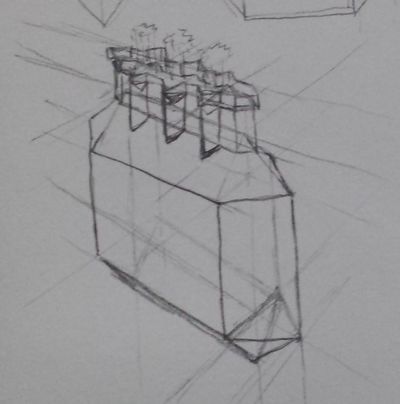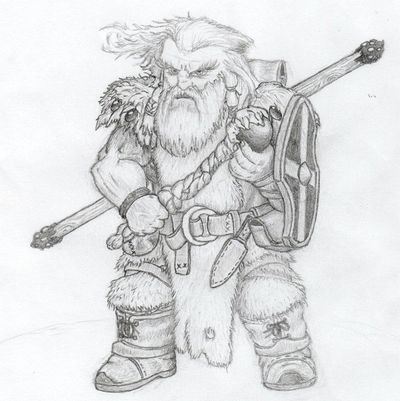Difference between revisions of "Dwarf"
| Line 36: | Line 36: | ||
== Half dwarves == | == Half dwarves == | ||
Dwarves didn't evolve naturally, like [[human]]s or [[ratel]]s, but were cast into their current shape by | Dwarves didn't evolve naturally, like [[human]]s or [[ratel]]s, but were cast into their current shape by [[Krohdin]], similar to [[elf|elves]] and [[halfling]]s. However, he did more or less base dwarves on humans (hush, don't tell the dwarves!), and as such they are capable of mating on the occasions the dwarves find other races preferable to their own, which is pretty rare though not unheard of. Another race included in a dwarven family usually have a lot of acclimatisation to do as the dwarven families rarely adopt the human traditions. | ||
== Nature Dwarves == | == Nature Dwarves == | ||
Revision as of 03:57, 8 October 2015
The race of dwarves are evolutionary separate from humans, elves and halflings that are short (around 120-140cm tall), but generally much stockier and stronger. It is a hardy race that has suffered much in the past few thousand years but they have not been crushed; it has made them stronger and more resolute.
Though dwarves feature prominently in old folk tales and epics, the race of shorter and stockier people are today seen by most humans to simbly be short and stocky humans, most are entirely unaware that they are their own species and that "dwarves exist". Dwarves don't mind this, though they get secretly insulted everyone implies they are of lowly human origin or "just like me".
History
The legends of the dwarves read that Krohdin, the Dwarven god, resided in a great mountain and was sleeping. As he was attacked by a malevolent pack of dragons that wanted to eat his heart, he was defended by the 'mountain dwellers', which were spirits of the mountain. The mountain dwellers perished in great numbers, but managed to fend the dragons off. As a reward for their actions Krohdin endowed the spirits with physical forms, similar to that of himself and gave them the mountains and bedrock as their domains. Early encounters with humans named them dwarves, a name they adopted and started wearing with immense pride.
This caused conflict with other creatures of earth and rock, creating long-lasting conflicts that eventually ended in a truce that has held until present day, though this 'victory' of sorts came at a high price.
Following the truce, as the dwarves and other earth-dwellers learned to co-exist and in some cases even cooperate, they started to become involved in the whims of the other gods. Krohdin was always very seclusive and shied away from contact with others, even the dwarves, but other gods made this impossible as what is now called the Dragon Wars erupted. Five terrible wars with dragon and hawk gods on either side of the battlefield with earthly dragons and hawks in the air and armies of mortals on the fields scorched the lands for millennia.
The allegiance of the dwarves shifted in the conflicts as their main motivation really was to be left well alone. They fought both besides and against humans and elves, often employing halflings for aid, but when they did fight, they clad themselves in minerals found in the deep earth and they fought hard. The main difference between the dwarves and the other humanoid races is that they never divided. In each war, all dwarves fought for the same side. Both humans and elves often had factions joining either faction and halflings assisted the side that seemed to be favored or they stayed away. In each war, the side the dwarves were on stood victorious, a fact they deem is their doing, though historians may disagree.
Despite suffering by most, these times are generally seen as the golden age of the dwarves. Most of the technological advances made by dwarvish culture took place during this time, as dwarves, though taking heavy casualties, survived in greater numbers than humans, and in far greater number than elves.

Before the start of the first Dragon War, the dwarves had begun building strongholds. Though fortified deep into bedrock, almost all of these fell during the war. During the Final Dragon War they had only two left, Gabilgathol and Kahz Valdahaz, which were both ruined by the two dragons Shorolthak and Inilthnesenth, a fracturing and a quaking dragon. They attacked Kahz Valdahaz first with their armies of blackfolk, orcs and some human tribes. Valdahaz as then the most populous of the dwarven power centres and an obvious choice. However, the dragons and their armies were held off by a very exhausted and weakened Krohdin joined by the main dwarven armies, assisted by other human tribes as well as halflings.
In the meanwhile Krohdin already bestowed most of his remaining power unto a set of dwarven artefacts heralding from before the wars, used to dig straight through bedrock and to further empower the very last stronghold: Gabilgathol. The extra weeks gained through this tactic enabled the dwarves to gut the entire mountain, creating the impossible: A floating gem doubling as a fortress.
Krohdin was killed together with every last man and woman battling the dragon armies, but most other dwarven civilians escaped alive, though this fact is something every dwarf takes to their grave. Their secret kingdom "elsewhere" that no one has ever found is actually circling the oceans. Another reason you often find Dwarves close to port towns around the globe.
Other races
Seen as just another human, just shorter and stockier (but not as a midget!), dwarves are quite accepted in the human realms. Generally, they are not even seen as a race. Though they have a homeland, they never speak of it, and even human scholars don't know much about it. Rumour has it it is destroyed or simply full or something in between.
Dwarves like the Northrealmers in particular for many traits, but also Midrealmers a lot for their openness and rich lifestyle. They are happy to join in a pub brawl and are seldom the guys needing much medical attention when it's over.
Dwarven individuals are known for their craftsmanship and the rumour even says some great craftsmen who also are short carry blood of the ancient dwarves an will make magical items if you pay well enough. Though several inquries have been done by The Sickle, and no traces of magic have been found in their workshops, shops homes or on their persons. The sickle takes any report of magic seriously.
The dwarves do like the southerners as well as a nice cultural exchange, but they are not too fond of the climate, and are quite uncommon in the south.
Dwarves get along well with halflings, and decently with elves, though some dwarves still hold animosity towards the elves and the mystics that wrought much death and destruction upon them. Elves appreciate dwarves for their skill, but still see them as a "lower" race. An important difference between elves and humans is that they do recognise them as an exiting race.
Half dwarves
Dwarves didn't evolve naturally, like humans or ratels, but were cast into their current shape by Krohdin, similar to elves and halflings. However, he did more or less base dwarves on humans (hush, don't tell the dwarves!), and as such they are capable of mating on the occasions the dwarves find other races preferable to their own, which is pretty rare though not unheard of. Another race included in a dwarven family usually have a lot of acclimatisation to do as the dwarven families rarely adopt the human traditions.
Nature Dwarves
Several hundred years ago, a small number of dwarves abandoned their lifestyle of materialistic gains and hollowing out the earth to join forces with human movements of druidic ideals where nature and man became one, primarily in the Wyrd kingdom. They separated themselves from the otherwise quite industrious and earth-obsessed members of the species, finding a connection with life above the surface. Though still worshipping the Dwarven God, they more actively followed a pursuit of maintaining nanture's willfull balance.
Many traditional dwarves feel they abandoned dwarvenkind, but the druidic dwarves still hold their arms and hearts open for the rest of dwarven kind. Little discussion happen between the two peoples, however.
The current leader of the druids in Caedweald, the largest druidic clan, is a dwarven woman named Ruvlaki.
Known Settlements
- Gabilgathol - Mythical home of Dwarves
- Kahz Valdahaz - Ruined stronghold during late Dragon Wars
- Khordaldrum - Ruined stronghold that is mythical but mostly unheard of but recently rediscovered
Characters
- Ruvlaki (f) - High Druid in Caedweald
Resources
- http://www.angelfire.com/pro/demon_1/dwarven_to_common_dictionary.htm
- http://www.bugmansbrewery.com/tutorials/article/115-dwarf-language-english-to-khazalid-dictionary/
| Factions nav (e) | ||||||||
|---|---|---|---|---|---|---|---|---|
| Main | Religions | Peoples | Kingdoms & Noble Houses (Ascendancy) | |||||
|
Alchemists' Guild |
Church of Rahn |
Dragons |
Artipellin |
|
Sovereigns Oakshield |
|
More Chivalric orders | |
|
Other: Tall | ||||||||
